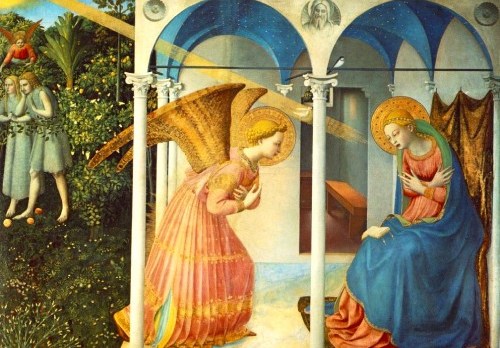Someone once told me that this event we have just heard in the gospel has been depicted in art more than any other in scripture, with the possible exception of the crucifixion. I’m not surprised. The Annunciation stirs the imagination in powerful ways – the human intersecting with the Divine in a moment unlike any other in history. It almost defies illustration. But countless artists have tried.
Very often, you will see Annunciation in a painting or stained glass window, and it’s depicted with one striking detail: Mary, holding in her hands or reading an open book. In fact, in the rectory office we have a statue of Mary as a little girl, standing beside her mother, St. Anne, and even there, she is carrying a book.
One artist has said this is to show Mary reading Isaiah, learning that a virgin would give birth to the savior. A priest friend once offered me a different take, saying that it shows her devotion to The Word – the Word that she would one day bring into the world as Jesus Christ.
However you interpret this detail, it remains a compelling way of thinking of Mary, especially as we near Christmas, and encounter readings like this one and think more deeply about The Word Made Flesh. And this morning, as we reflect on The Word, I wanted to look more closely at one word in particular that recurs in this passage. It’s a word Luke uses again and again in the story of the Nativity, three times alone in just this short passage. You might easily overlook it. But we shouldn’t.
The word is simple, but deliberate:
“Behold.”
In literal terms, it means: “To see,” or “Observe.”
But in scriptural terms, it goes even deeper. It is emphatic. It’s like a yellow highlighter in Luke’s hand, drawing our attention.
And so we have the angel Gabriel underscoring his annunciation.
Twice, he says: “Behold!” Look! Miracles are unfolding around you and within you. Behold!
And what does Mary say in response?
She replies to the angel, and to us, with the same word. In a way, she speaks to him in his own language. Coming from her own lips, it has even more impact.
Behold, she says. I am the handmaid of the Lord.
In other words: Look! You have told me some thing extraordinary. And now, here, before you, is something else extraordinary: a woman ready to do God’s will. I am His handmaid. His servant.
In effect, Mary, this woman of The Word, a woman so often depicted with an open book, is saying: the rest of the pages of my life are blank. I am God’s book now. Let Him write His story within me.
Behold.
But there is even more to this moment – something that has implications for all of us.
We tend to think of the Annunciation as focusing on the angel telling Mary what is about to happen.
But I’d like to suggest another Annunciation in this scene from Luke.
It’s not what the angel says to Mary. It’s what Mary says to the angel.
It is the moment when Mary declares her consent — surrendering to God’s will, sacrificing herself and her life for Him and, ultimately, for us.
Behold, she announces. I am His.
It is that “Annunciation within the Annunciation” that, I think, speaks to all of us. It is dramatic. It is humbling.
And it is ours.
Because in that moment, if we let her, Mary speaks for all of us.
We aren’t all going to encounter angels, announcing to us that we are going to be part of salvation history.
But we all can declare our own desire to continue what Mary began – our desire to help bring Christ into the world. And it starts, as it did with Mary, by giving ourselves over to God’s will for us – His surprising, sometimes challenging plan for us.
If someone had told me 20 years ago that one day I’d be standing in this pulpit, wearing these vestments, preaching every Sunday morning, I would have laughed.
But God knew better. He had something planned. He does for all of us. Just as he did for Mary.
As one commentator has put it: unlike most of us, Mary didn’t pray, “Thy will bechanged.”
She said, instead, “Thy will be done.”
Following her beautiful example, we can also follow her faith, her obedience, her trust, her love. And in doing that, we can also, like Mary, help make Christ manifest. We can help him to be born once again into our world – a world desperately in need of mercy. And charity. And compassion. And hope.
We can remind others of “Emmanuel” – that God is with us.
That is our call — not just at Christmas, but every day. God is asking us to do nothing less than to continue the Incarnation.
What will be our answer?
“Behold” was the cry of angels, and the affirmation of Mary, and it can be ours, as well.
We can make it our own fiat, our own assent.
So, this week, these last days of Advent, in this time of waiting: let us wait, and pray — and behold.
Behold – our own yearning for the Prince of Peace to come into our world.
Behold – a woman who gave herself to God, and gave to us an example of obedience and faith.
Behold – like an open book, our lives are waiting for God to write His story within us.


